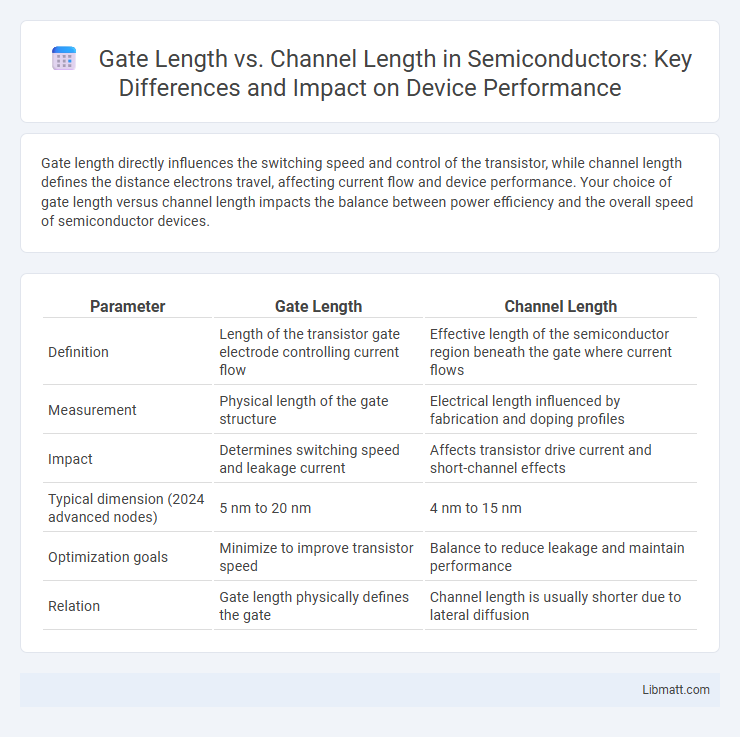Gate length directly influences the switching speed and control of the transistor, while channel length defines the distance electrons travel, affecting current flow and device performance. Your choice of gate length versus channel length impacts the balance between power efficiency and the overall speed of semiconductor devices.
Table of Comparison
| Parameter | Gate Length | Channel Length |
|---|---|---|
| Definition | Length of the transistor gate electrode controlling current flow | Effective length of the semiconductor region beneath the gate where current flows |
| Measurement | Physical length of the gate structure | Electrical length influenced by fabrication and doping profiles |
| Impact | Determines switching speed and leakage current | Affects transistor drive current and short-channel effects |
| Typical dimension (2024 advanced nodes) | 5 nm to 20 nm | 4 nm to 15 nm |
| Optimization goals | Minimize to improve transistor speed | Balance to reduce leakage and maintain performance |
| Relation | Gate length physically defines the gate | Channel length is usually shorter due to lateral diffusion |
Understanding Gate Length and Channel Length
Gate length refers to the physical dimension of the transistor gate controlling current flow, while channel length is the distance between the source and drain regions where the channel forms under the gate. Understanding both parameters is crucial for semiconductor device performance as gate length impacts switching speed and leakage, whereas channel length influences current drive and short-channel effects. Precise control of gate and channel lengths enables optimization of transistor scaling in advanced CMOS technologies.
Key Differences Between Gate Length and Channel Length
Gate length refers to the physical dimension of the transistor's gate electrode, controlling the flow of current in the device. Channel length, on the other hand, is the effective length of the semiconductor region through which charge carriers move from source to drain. Understanding the distinction between gate length and channel length is crucial for optimizing transistor performance and scaling in semiconductor technology.
Importance in Semiconductor Device Performance
Gate length critically influences semiconductor device performance by directly affecting transistor switching speed and power consumption. Shorter gate lengths enable faster switching and higher transistor density, enhancing overall circuit speed, but also increase leakage currents and short-channel effects. Precise control of channel length is essential to balance drive current, threshold voltage stability, and minimizing off-state leakage, ensuring optimal device reliability and efficiency.
Influence on Transistor Scaling
Gate length directly affects transistor switching speed and leakage current, crucial for advanced semiconductor scaling. Channel length determines the distance carriers travel, influencing drive current and short-channel effects that impact device performance and power consumption. Optimizing the ratio between gate length and channel length is essential for improving transistor reliability and scaling your integrated circuits effectively.
Gate Length vs Channel Length in MOSFETs
Gate length in MOSFETs refers to the physical dimension of the gate electrode, directly controlling the channel region beneath it, while channel length is the effective distance between the source and drain through which carriers flow. The gate length typically defines the minimum channel length but may differ due to lateral diffusion and fabrication variances, impacting device performance such as drive current and short-channel effects. Precise control of gate length relative to channel length is critical in scaling MOSFET devices to maintain threshold voltage stability, reduce leakage currents, and enhance switching speeds.
Impact on Short-Channel Effects
Gate length and channel length are critical factors influencing short-channel effects in transistors, with shorter gate lengths generally intensifying these effects due to reduced control over the channel. The degree to which the gate length approximates the channel length determines the electrostatic integrity, affecting threshold voltage roll-off and drain-induced barrier lowering (DIBL). Optimizing your device design involves balancing gate and channel lengths to mitigate short-channel effects and maintain transistor performance in scaled technologies.
Role in Power Consumption and Speed
Gate length directly influences the switching speed of a transistor by controlling the distance electrons travel, with shorter gate lengths enabling faster switching and improved performance. Channel length impacts power consumption through leakage currents; shorter channels often increase leakage, raising static power usage. Optimizing your device's gate and channel lengths balances high-speed operation with minimized power consumption for efficient semiconductor performance.
Technological Challenges in Minimization
Minimizing gate length relative to channel length presents significant technological challenges due to short-channel effects, including increased leakage currents and reduced control over the channel by the gate electrode. Advanced lithography techniques and novel materials are required to maintain precise dimensional control while preventing electron mobility degradation and threshold voltage variability. Overcoming quantum mechanical tunneling and variability in dopant distribution also limits further scaling in traditional silicon-based transistors.
Measurement Techniques for Gate and Channel Lengths
Accurate measurement of gate length and channel length is crucial for semiconductor device performance optimization, often achieved using advanced metrology techniques such as scanning electron microscopy (SEM) and transmission electron microscopy (TEM). Critical dimension scanning electron microscopy (CD-SEM) provides high-resolution gate length measurements by detecting the edges of the gate structure, while cross-sectional TEM offers precise visualization of the channel length by imaging the device architecture at the atomic scale. These techniques, combined with atomic force microscopy (AFM) and scatterometry, enable effective analysis of dimensional variations and fabrication process control in modern integrated circuits.
Future Trends in Device Miniaturization
Future trends in device miniaturization emphasize the shrinking of gate length rather than channel length to enhance transistor performance and reduce power consumption. Gate length scaling improves control over the channel, minimizing short-channel effects and enabling higher switching speeds in advanced semiconductor devices. You can expect ongoing innovations in gate materials and multi-gate architectures to sustain Moore's Law and push device dimensions below the 5-nanometer scale.
Gate Length vs Channel Length Infographic

 libmatt.com
libmatt.com